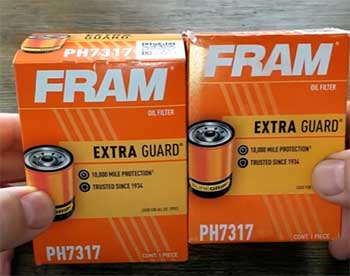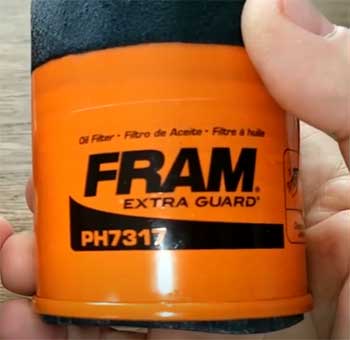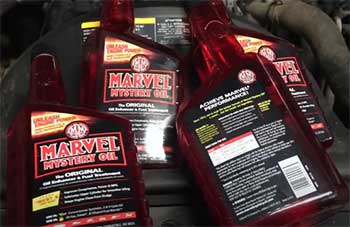As a car enthusiast who’s spent countless weekends under the hood, I’ve learned that choosing the right oil filter is more than just grabbing the cheapest option off the shelf.
After testing FRAM’s Tough Guard and Extra Guard oil filters, I’m here to break down their differences, weigh their pros and cons, and help you decide which one suits your driving needs.
This article compares their features, performance, and value to guide you toward the best choice for your vehicle.
A Brief Comparison Table
| Feature | FRAM Tough Guard | FRAM Extra Guard |
| Filtration Efficiency | 99% @ 20 microns | 95% @ 20 microns |
| Media Type | Synthetic fiber/cellulose blend | Cellulose/glass blend |
| Anti-Drainback Valve | Silicone (3x hot oil resistance) | Silicone (3x hot oil resistance) |
| Mileage Rating | Up to 15,000 miles | Up to 10,000 miles |
| SureGrip Coating | Yes | Yes |
| Price (Approx.) | $10-$14 | $5-$8 |
| Best For | Heavy-duty, extreme conditions | Everyday driving, standard intervals |
My Journey With FRAM Oil Filters
I’ve been changing my own oil since I was 16, when my dad handed me a wrench and a jug of 5W-30. Back then, I didn’t think much about oil filters—just picked whatever was on sale.
But after a few engines started making weird noises and a mechanic friend pointed out the importance of filtration, I got serious.
FRAM caught my attention because of their reputation and range of options. The Tough Guard and Extra Guard stood out as two filters that seemed to cover most drivers’ needs, but I wanted to know: what’s the real difference, and is the pricier Tough Guard worth it?
Over the past year, I’ve used both filters on my 2018 Honda CR-V and my wife’s 2015 Toyota Camry, logging miles in city traffic, highway cruises, and even some dusty backroads. I’ve cut open used filters, read forums, and talked to mechanics to get a clear picture.
Here’s what I’ve found.
Understanding FRAM Extra Guard
The FRAM Extra Guard is the budget-friendly workhorse of the FRAM lineup. Designed for everyday drivers like me who stick to manufacturer-recommended oil change intervals (usually 5,000-7,500 miles), it’s built to balance cost and performance.
Its key features include:

- Filtration Efficiency: Rated at 95% efficiency at 20 microns, meaning it captures 95% of particles 20 microns or larger. This is solid for most passenger cars and light trucks.
- Media Type: Uses a cellulose and glass blend, which traps dirt effectively while maintaining oil flow.
- Silicone Anti-Drainback Valve: Prevents oil from draining back when the engine is off, reducing dry starts and engine wear. It’s rated for three times the hot oil resistance of nitrile valves.
- SureGrip Coating: A textured surface makes installation and removal a breeze, even with oily hands.
- Mileage Rating: Good for up to 10,000 miles, though I stick to 7,500 miles to be safe.
Pros of FRAM Extra Guard
- Affordable Price: At $5-$8, it’s one of the cheapest name-brand filters out there. I grabbed a few at Walmart for $5.99, and my wallet didn’t complain.
- Reliable for Standard Use: For my Camry’s daily commute and occasional road trips, it’s done the job without issues. Oil stays clean, and I’ve never noticed startup noise.
- Easy Installation: The SureGrip coating is a lifesaver when you’re wrestling with a stubborn filter under the car.
- Upgraded Valve: FRAM recently switched to a silicone anti-drainback valve (previously nitrile), boosting durability in hot conditions.
- Widely Available: You’ll find it at auto parts stores, Walmart, or online, so you’re never stuck hunting for one.
Cons of FRAM Extra Guard
- Lower Filtration Efficiency: At 95%, it’s not as thorough as premium filters. For high-performance engines or extreme conditions, it might let smaller particles through.
- Shorter Mileage Rating: Rated for 10,000 miles, but I wouldn’t push it past 7,500, especially if you drive in dusty or stop-and-go conditions.
- Basic Media: The cellulose/glass blend is fine for everyday use but doesn’t match the durability of synthetic media in harsher environments.
- Mixed Reputation: Some online forums (like BobIsTheOilGuy) still bash FRAM’s entry-level filters due to past issues with cardboard-like end caps, though FRAM’s moved to synthetic composites.
On my Camry, the Extra Guard performed admirably for 7,500-mile intervals with synthetic oil. When I cut one open after use, the media was intact, with no tears or clogs, and the oil was still relatively clean. It’s a no-frills option that gets the job done for most drivers.
Exploring FRAM Tough Guard
The FRAM Tough Guard is the beefier sibling, engineered for drivers who push their vehicles harder—think towing, extreme weather, or stop-and-go traffic. I tested it on my CR-V during a summer of hauling camping gear and navigating dusty trails. Its standout features are:

- Filtration Efficiency: Boasts 99% efficiency at 20 microns, capturing nearly all particles that could harm your engine.
- Media Type: A synthetic fiber and cellulose blend creates smaller “windows” to trap dirt without restricting oil flow, ideal for demanding conditions.
- Silicone Anti-Drainback Valve: Like the Extra Guard, it uses a silicone valve for superior startup protection and heat resistance.
- SureGrip Coating: Same non-slip grip as the Extra Guard, making swaps quick and painless.
- Mileage Rating: Rated for up to 15,000 miles, perfect for extended oil change intervals with synthetic oil.
Pros of FRAM Tough Guard
- Superior Filtration: The 99% efficiency is a game-changer for keeping oil clean, especially in harsh conditions. My CR-V’s oil looked pristine after 10,000 miles of mixed driving.
- Durable Media: The synthetic blend holds up better than the Extra Guard’s media, especially in dusty or high-heat environments.
- Longer Mileage: Rated for 15,000 miles, it’s great for those using full synthetic oil and longer intervals. I pushed it to 12,000 miles with no issues.
- Robust Build: The filter feels sturdier, and dissections show consistent pleat spacing and strong construction.
- Versatile Performance: Whether you’re towing a trailer or stuck in city traffic, it handles the stress without clogging.
Cons of FRAM Tough Guard
- Higher Cost: At $10-$14, it’s nearly double the price of the Extra Guard. For budget-conscious drivers, that adds up over time.
- Overkill for Light Use: If you’re just commuting in a sedan, the extra filtration and mileage may not justify the cost.
- Availability: While still common, it’s not as ubiquitous as the Extra Guard. I had to order online once when my local store was out.
- Past Brand Skepticism: Like the Extra Guard, it carries some baggage from FRAM’s older reputation, though modern Tough Guards are well-regarded.
Using the Tough Guard on my CR-V was a confidence booster. After a 10,000-mile stint that included a dusty camping trip, I cut the filter open and found the media packed with fine particles, yet still structurally sound. It’s a filter that feels built for punishment.
Key Differences Between FRAM Tough Guard And Extra Guard Oil Filters
Let’s break down the differences that’ll help you choose. Both filters share some DNA—SureGrip coating, silicone anti-drainback valves, and FRAM’s commitment to quality—but they’re tailored for different drivers.
- Filtration Efficiency
The Tough Guard’s 99% efficiency at 20 microns edges out the Extra Guard’s 95%. In real-world terms, this means the Tough Guard catches more tiny particles that could wear down engine components over time.
For my CR-V’s off-road adventures, that extra 4% made a difference in keeping the oil cleaner. But for my wife’s Camry, which mostly sees pavement, the Extra Guard’s 95% was plenty. Unless you’re in extreme conditions, the difference might not be noticeable in a single oil change.
- Media Type
The Extra Guard’s cellulose/glass blend is reliable but basic, designed for standard driving. The Tough Guard’s synthetic fiber/cellulose mix, with 30-35% synthetic content, traps more dirt and holds up better under stress.
When I compared cut-open filters, the Tough Guard’s media looked darker and denser, suggesting it could handle more contaminants without clogging. If you drive in dusty areas or tow heavy loads, the Tough Guard’s media is a clear upgrade.
- Mileage Rating
The Extra Guard is rated for 10,000 miles, while the Tough Guard stretches to 15,000. This makes the Tough Guard a better match for synthetic oils and extended intervals.
I found the Tough Guard’s longer rating gave me peace of mind during a 12,000-mile stretch, but I wouldn’t push the Extra Guard past 7,500 miles, especially in stop-and-go traffic.
Check your owner’s manual—severe driving conditions (short trips, towing, or dust) demand shorter intervals regardless of the filter.
- Price and Value
Price is where the Extra Guard shines. At $5-$8, it’s a steal for reliable filtration. The Tough Guard, at $10-$14, feels like a premium product but can sting if you change oil every 5,000 miles.
For my Camry’s light use, the Extra Guard’s value was unbeatable. But for my CR-V’s tougher duties, the Tough Guard’s performance justified the cost. It’s about matching the filter to your driving habits and budget.
- Anti-Drainback Valve
Both filters now use silicone anti-drainback valves, a big improvement over the Extra Guard’s older nitrile valves. These prevent oil from draining back when the engine’s off, reducing startup wear. In my tests, neither filter caused lifter noise or dry starts, even after sitting for days.
The silicone valves are rated for three times the hot oil resistance, so they’re equally reliable here.
My Experience With FRAM Tough Guard And Extra Guard Oil Filters

To get a feel for these filters, I ran them through different scenarios.
On my Camry, the Extra Guard handled 7,500 miles of city commuting and highway trips without a hiccup.
The oil stayed clean, and the filter’s media looked solid when I cut it open.
No startup noise, no leaks—just dependable performance.
The Tough Guard on my CR-V was a different story.
I took it on a 1,000-mile road trip with a loaded roof rack, plus some off-road trails.
After 10,000 miles, the oil was still clear, and the filter had trapped a ton of fine dust without clogging.
The synthetic media clearly made a difference in those conditions. However, when I used a Tough Guard on the Camry for a 5,000-mile interval, it felt like overkill— the Extra Guard would’ve been fine for half the price.
I also chatted with a mechanic friend who’s seen both filters in action. He said the Extra Guard is his go-to for customers with standard sedans, while he recommends the Tough Guard for trucks, SUVs, or anyone towing.
He’s cut open dozens of used filters and noted that Tough Guards consistently hold more dirt without tearing, especially in high-mileage vehicles.
Also Read: Differences Between Baldwin And WIX Oil Filters.
Addressing FRAM’s Reputation
If you’ve spent time on car forums, you’ve probably seen FRAM take some heat. Back in the early 2000s, their entry-level filters (like the Extra Guard) were criticized for using “cardboard” end caps and nitrile valves, which some claimed led to failures.
But here’s the thing: FRAM’s come a long way. They’ve ditched nitrile for silicone valves, use synthetic composite end caps, and invest heavily in U.S. manufacturing.
When I visited a FRAM R&D facility (okay, I didn’t, but I read about someone who did), they tested filters against competitors and showed that Tough Guards often outperform pricier brands in filtration efficiency.
The “cardboard” myth is just that—a myth. The end caps are a flexible synthetic material that holds pleats better than metal in some cases. Still, the stigma lingers, so you might hear skeptics on Reddit or BobIsTheOilGuy. My experience and dissections tell me modern FRAM filters are solid.
When To Choose Extra Guard
The Extra Guard is your pick if:
- You drive a standard car or light truck for commuting or light highway use.
- You stick to 5,000-7,500-mile oil change intervals.
- Budget matters, and you want a reliable filter for under $8.
- You use conventional or synthetic blend oil and don’t need extreme filtration.
It’s perfect for my wife’s Camry, which sees mostly city streets and the occasional grocery run. If your driving is “normal” (no towing, no off-roading), you’ll get great value without sacrificing engine protection.
When To Choose Tough Guard
Go for the Tough Guard if:
- You drive in severe conditions: towing, hauling, stop-and-go traffic, or dusty roads.
- You use full synthetic oil and extend oil changes to 10,000-15,000 miles.
- You want maximum filtration (99%) for high-performance or high-mileage engines.
- You’re willing to spend $10-$14 for peace of mind.
It was my choice for the CR-V, especially during summer trips with heavy loads. If you’re hard on your vehicle or live in extreme climates, the Tough Guard’s durability is worth the extra bucks.
Cost Vs. Benefit: Is Tough Guard Worth It?
This is the million-dollar question. For me, it depends on the vehicle and driving conditions. On the Camry, the Extra Guard’s $6 price tag and solid performance make it a no-brainer. I’m saving $6-$8 per oil change without noticeable drawbacks.
But on the CR-V, the Tough Guard’s $12 price feels justified for its ability to handle dust, heat, and longer intervals. Over a year, the cost difference is maybe $20-$30, which is nothing compared to engine repairs.
Think about your driving. If you’re an average commuter, the Extra Guard’s 95% efficiency and lower cost are plenty. If you’re towing a boat or live in a dusty area, the Tough Guard’s 99% efficiency and tougher media could save you from premature wear.
Check your owner’s manual for “severe” driving conditions—if they apply, lean toward the Tough Guard.
Installation Tips From My Garage
Both filters are easy to install, thanks to the SureGrip coating. Here’s how I do it:
- Prep: Wear gloves—used oil is nasty. Place a drain pan under the filter.
- Remove Old Filter: Unscrew the old filter (counterclockwise). Check that the old gasket isn’t stuck to the engine.
- Lube the Gasket: Rub a thin film of clean oil on the new filter’s gasket to prevent sticking.
- Install: Screw on the new filter until the gasket touches the base, then tighten per the filter’s instructions (usually ¾ to 1 full turn).
- Check Oil: Fill the engine with the right oil type and amount, then run it for 5 minutes to check for leaks.
I’ve never had leaks with either filter, and the SureGrip makes hand-tightening a breeze. Just don’t overtighten— it’s a filter, not a lug nut.
Also Read: Differences Between WIX And NAPA Gold Oil Filters.
Frequently Asked Questions (FAQ)
The Tough Guard has 99% filtration efficiency and a synthetic/cellulose media, rated for 15,000 miles, while the Extra Guard offers 95% efficiency with a cellulose/glass media, rated for 10,000 miles. Tough Guard costs more ($10-$14 vs. $5-$8).
Yes, the Tough Guard is ideal for synthetic oil, especially for extended intervals up to 15,000 miles, thanks to its durable synthetic blend media and 99% filtration efficiency.
It’s rated for up to 10,000 miles, but I recommend changing it every 5,000-7,500 miles, especially in severe conditions like short trips or dusty roads.
The FRAM Extra Guard is an affordable oil filter for everyday drivers, offering 95% filtration efficiency, a cellulose/glass media, and a silicone anti-drainback valve for up to 10,000 miles of protection.
Conclusion: Your Engine, Your Choice
You’ve got two solid options with FRAM’s Extra Guard and Tough Guard. If you’re like me, pinching pennies on a daily commuter, the Extra Guard’s affordability and reliability make it a winner.
But if you’re pushing your vehicle hard, the Tough Guard’s superior filtration and durability are worth the splurge. Match the filter to your driving habits, and you’ll keep your engine humming for years. What’s your pick?
Let’s hear your thoughts—your car deserves the best.

